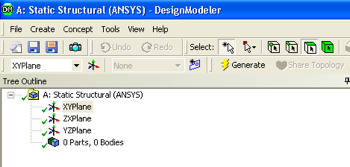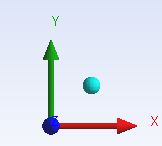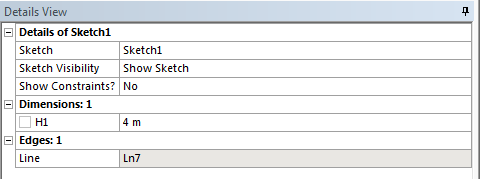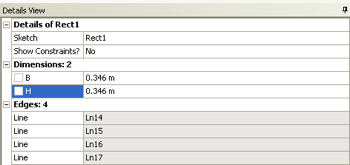For users of ANSYS 15.0, please check this link for procedures for turning on the Auto Constraint feature before creating sketches in DesignModeler. |
The process we'll follow is:
In order to make sure the geometry data gets transferred to the Model a couple of steps must be taken; First, right click on Geometry then click on Properties . Under Properties of Schematic A3: Geometry expand Basic Geometry Options and check the box to the right of Line Bodies as seen below. If you are using a later version such as ANSYS 15.0, you can skip this step.

Double-click on the geometry button,  ; in the Project Schematic area, which should launch the Design Modeler in ANSYS. A window should pop up asking for units. Units are in meters, so select Meters and press Ok . A folder called A: Static Structural (ANSYS) should be expanded in the tree outline of the Design Modeler; If it is not expanded, then expand it now.
; in the Project Schematic area, which should launch the Design Modeler in ANSYS. A window should pop up asking for units. Units are in meters, so select Meters and press Ok . A folder called A: Static Structural (ANSYS) should be expanded in the tree outline of the Design Modeler; If it is not expanded, then expand it now.

Click once on the XYPlane button,  ; Next, click once on the royal blue Z vector (displayed below) which should be in the bottom right section of the Design Modeler window.
; Next, click once on the royal blue Z vector (displayed below) which should be in the bottom right section of the Design Modeler window.

Now, you should be looking directly at the XY plane and the axes in the bottom right corner should be oriented as they are in the image below.

First instinct is to make a rectangular solid as a model for our cantilever. This would create 3D elements which would be one way of modeling the beam. Here we will use a different modeling approach using 1D beam elements. In effect, we are only modeling the neutral axis of the beam and calculating its deformation directly. All other results such as bending stress and bending moment are derived from the deformation of the neutral axis.
Let's create a line corresponding to the undeformed neutral axis. Click once on the Sketching tab,  , which appears at the bottom of the Tree Outline. Click once on the Line button,
, which appears at the bottom of the Tree Outline. Click once on the Line button,  , in the Draw tab,
, in the Draw tab,  , that automatically appears. Then place the mouse cursor directly over the origin of the XY plane until a P appears (the P indicates that the cursor is co-incident with the Point at the origin). If you don't see the P, you need to turn on the Auto Constraint feature as shown here. This step is necessary in version 15.0 as noted at the top of this page. In other versions, the Auto Constraint feature is turned on by default.
, that automatically appears. Then place the mouse cursor directly over the origin of the XY plane until a P appears (the P indicates that the cursor is co-incident with the Point at the origin). If you don't see the P, you need to turn on the Auto Constraint feature as shown here. This step is necessary in version 15.0 as noted at the top of this page. In other versions, the Auto Constraint feature is turned on by default.

Once the P appears then click once on the mouse. Next, move the mouse over to the right so it lies somewhere on the positive x axis; Prior, to clicking again make sure that a C appears (the C indicates that the cursor is Co-incident with the horizontal axis)..

You should now have a line that starts at the origin and terminates somewhere on the positive axis.
At this point, the dimension of the line needs to be specified, so click once on the Dimensions tab,  . Click on the line and place the dimension as shown below. You should see a dimension labeled H1 above the horizontal line as shown below. Note that there is an Undo button in the sketching mode that you can use if you make a mistake.
. Click on the line and place the dimension as shown below. You should see a dimension labeled H1 above the horizontal line as shown below. Note that there is an Undo button in the sketching mode that you can use if you make a mistake.
Now, the length of the line will be manually edited. Underneath the Sketching Toolboxes there will be a column called Details View. In Details View there is a subcategory called Dimensions: 1 . Change the numerical value of H1 to 4 meters and press enter.

The next step is to turn our "line sketch" into a "line body". In ANSYS, only "bodies" can be meshed. In order to do this click on Concept which will be on top of the Design Modeler window, then click on Lines from Sketches, as can be seen in the following picture.

Next, click on the blue horizontal line that you drew. The blue horizontal line should have changed from blue to yellow as can be seen below.

In the Details View column a yellow box to the right of Base Objects should be highlighted in yellow. Click on the yellow box and then click apply . Then, click on the Generate button  ; it is located on the top left portion of the Design Modeler.
; it is located on the top left portion of the Design Modeler.
Now, the beam cross section will be defined. First go to Concept then click on Cross Section then finally click on Rectangular, as shown below.

Now, the width and height of the cross section need to be defined; Under "Details View" set B to 0.346 meters and set H to 0.346 meters, as can be seen below;

Then click on the Generate button,  .
.
This is an optional step that will only change the way the cross-section is displayed, so you can choose to skip it. You can right click on the dimension and select Move Dimensions and move the dimensions closer to the cross section. The cross section will be easier to see if you click on the zoom to fit tool |
Now the defined cross section will be assigned to the line body. ANSYS will then use this cross-section to calculate the moment of inertia while forming the element stiffness matrices. First, expand "1 Part, 1 Body" which is located in the Tree Outline. Next, click on Line Body , and there should be a yellow box to the right of Cross Section under the Details of Line Body. Click on the yellow box and select rect1 as seen below.

We can visualize the beam in 3D by getting ANSYS to wrap the cross-section around the line in the display. Click on View > Cross Section Solids, as shown below;

If you click on the 1 Cross Section ,  , in the Tree Outline and then click on the light blue dot,
, in the Tree Outline and then click on the light blue dot,  , you should now see a three dimensionally rendered beam in an isometric view. Note that this is merely a visualization; our beam model is only a line.
, you should now see a three dimensionally rendered beam in an isometric view. Note that this is merely a visualization; our beam model is only a line.

At this point, the Design Modeler window can be closed. Then, click on Save.
Go to all ANSYS Learning Modules